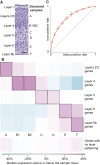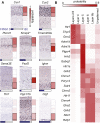A transcriptomic atlas of mouse neocortical layers - PubMed (original) (raw)
A transcriptomic atlas of mouse neocortical layers
T Grant Belgard et al. Neuron. 2011.
Abstract
In the mammalian cortex, neurons and glia form a patterned structure across six layers whose complex cytoarchitectonic arrangement is likely to contribute to cognition. We sequenced transcriptomes from layers 1-6b of different areas (primary and secondary) of the adult (postnatal day 56) mouse somatosensory cortex to understand the transcriptional levels and functional repertoires of coding and noncoding loci for cells constituting these layers. A total of 5,835 protein-coding genes and 66 noncoding RNA loci are differentially expressed ("patterned") across the layers, on the basis of a machine-learning model (naive Bayes) approach. Layers 2-6b are each associated with specific functional and disease annotations that provide insights into their biological roles. This new resource (http://genserv.anat.ox.ac.uk/layers) greatly extends currently available resources, such as the Allen Mouse Brain Atlas and microarray data sets, by providing quantitative expression levels, by being genome-wide, by including novel loci, and by identifying candidate alternatively spliced transcripts that are differentially expressed across layers.
Copyright © 2011 Elsevier Inc. All rights reserved.
Figures
Figure 1
Laminar Dissections Correspond to Known Cytoarchitectural Layers (A) Samples were dissected manually using microsurgical scalpel under binocular microscope from coronal sections of primary somatosensory cortex. Nissl stain of RNA reveals layers with different cell densities across adjacent layers 1–6b and their correspondence to laminarly dissected samples (scale bar represents 200 μm). (B) Genome-wide RNA-Seq gene expression patterns (see also Table S1) across samples A–F recapitulate gene expression preferences in layers 2–6b known from manual curation (Lein et al., 2007). The heatmap reflects the relative RNA-Seq expression across samples of “patterned” genes known to be expressed in one (or more) neocortical layer. Demonstrated correspondences between dissected layers and samples are highlighted with outlined red panels on the descending diagonal. The lowest set of panels indicates genes that show no layer patterning. If genes gl are annotated (Lein et al., 2007) as being preferentially expressed in layer l and fsgl is the fractional expression of gene gl in sample s relative to expression in all samples, then tsl is the median of (fsgl) over genes gl. The heat map represents [tsl – meanall layers_l_ (tsl)]/[meanall layers_l_ (tsl)]. (C) This correspondence allowed apparent layer enrichment to be predicted from expression across dissected samples with naive Bayes classifiers. The receiver operating characteristic (ROC) curve for the layer 5 classifier is shown, as it yields a middling _a_rea _u_nder the ROC _c_urve (AUC) (Table 1; Figure S1). Error bars indicate sample standard deviations based on 10-fold cross validation.
Figure 2
Classifiers Recapitulate Classical Layer Markers, Enrich Existing In Situ Hybridizations with Quantitative Data, and Greatly Expand the Number of Known Genic Layer Markers (A) Classifier predictions typically recapitulated known layer markers. Calibrated layer enrichment probabilities for eleven classical layer markers (Molyneaux et al., 2007) are represented to the right of the corresponding in situ hybridization image reproduced with permission from the Allen Mouse Brain Atlas (Lein et al., 2007) (Supplemental Experimental Procedures). Boxes outlined in black indicate that the classifier predicted the gene to be “enriched” in that layer. Blue bars beneath each image represent the highest expression level of that gene in any sample, highlighting an additional dimension of information. Common synonyms for these genes include Darpp32 (Ppp1r1b), Igh6 (Ighm), and C030003D03Rik (Tmem200a). ∗Kcnip2 was the only image from a sagittal, as opposed to a coronal, section. (B) In addition to increasing the number of known (Lein et al., 2007) layer-patterned genes by 3- to 4-fold (Figure S3), these classifiers are also informative for genes that already have high-throughput in situ hybridization images. This is illustrated by calibrated layer enrichment probabilities of 20 of the most highly patterned genes encoding receptors, selected blindly to status in the Allen Mouse Brain Atlas, in which 9 were qualitatively consistent, 4 had a faint signal, 3 had a ubiquitous signal, 3 were qualitatively inconsistent, and 1 had a failed probe (Table S3). Our classifiers provide an objective evaluation of cortical patterning for these genes with ambiguous images.
Figure 3
Osbp2 Shows Signs of Differential Expression of its Isoforms across Layers (A) Normalized read depth across samples A–F in the mouse chr11:3,593,238-3,771,939 region. Two isoforms account for most expression from this locus: ENSMUST00000070552 and ENSMUST00000101633. Yellow boxes highlight read coverage in mutually exclusive exons outlined in green. The FPKM of ENSMUST00000070552 was significantly higher in sample F than in sample B1, whereas the FPKM of ENSMUST00000101633 was significantly higher in sample B1 than in sample F, indicating that both transcripts are differential expressed across samples. The probe used for in situ hybridization in the Allen Mouse Brain Atlas (RP_050125_02_B09) does not discriminate between these isoforms. (B) Classifiers predict that ENSMUST00000070552 is enriched in deeper layers whereas ENSMUST00000101633 is enriched in upper layers. See Figure S4 for a complex neurologically relevant example and Table S4 for the layer enrichment probabilities of additional candidate alternatively spliced genes.
Figure 4
Genes Enriched in Expression for Specific Layers Are Significantly Associated with Specific Diseases and Functions (A) Selected functional classes of genes whose expression across neocortical layers is significantly patterned (all genes predicted to be preferentially expressed in one or more layers) or unpatterned (predicted to have no layer enrichment). Significance was assessed with a two-tailed Fisher's exact test, followed by a q value multiple testing correction. All of these terms were replicated with a p value of lower than 0.05 in either dorsal or lateral cortex (Table S6). The full list of significant terms is provided in Belgard et al. (2011). Sig, significance (∗q < 0.05; ∗∗q < 0.01, ∗∗∗q < 0.001); FE, fold enrichment over expected. (B) Distributions of genes across layers of selected functions that were significantly patterned in either the original set or one of the replication sets with a Bonferroni-corrected p < 0.05. See Table S6 for a complete nonredundant list of enriched terms and also for both replications. Where the observed percentage of genes in a layer differs significantly from the expected percentage of genes in a layer, we list the appropriate p or q values smaller than 0.05, as assessed by a bias-corrected simulation method (Supplemental Experimental Procedures). (C) Distributions of genes across layers of selected functions that were significantly enriched in one layer (q < 0.05), as assessed by a bias-corrected simulation method (Supplemental Experimental Procedures). Terms were drawn from the following databases, as cited: 1Gene Ontology (Ashburner et al., 2000) Cellular Component, 2Molecular Function, and 3Biological Process; 41:1 mouse orthologs of human genes previously associated with human traits and diseases (Chen et al., 2010); 5Kyoto Encyclopedia of Genes and Genomes (Kanehisa et al., 2004); and 6mouse knockout phenotypes (Blake et al., 2011). See also Figure S5 and Table S5.
Figure 5
Anxa5 Cortical Expression Overlaps with that of its Neighboring Cortical lincRNA (Gm11549) (A) Read depth from all cortical RNA-seq data, and multiexonic de novo transcripts, in the mouse chr3:36,347,839-36,431,074 region. Of all predicted Ensembl [coding (red) and noncoding (pink)] and RefSeq gene annotations in this region, only Anxa5 and Gm11549 were expressed. All transcripts overlapping Gm11549 were predicted with high confidence to be noncoding except for the one marked in gray, which had a short open reading frame covering less than 8% of the mostly repeat-derived transcript. Locations of the in situ probes are indicated in purple. (B) Calibrated cortical layer enrichment probabilities for Anxa5 (ENSMUSG00000027712) and Gm11549 (de novo model XLOC_901616). Both genes were predicted to be enriched in layer 5 (uncalibrated probability > 0.5). (C and D) In situ hybridizations for (C) Anxa5 and (D) Gm11549 confirmed that their expression in the mouse cortex was as predicted. (E) Cortex stained for Nissl. The maximum read depth at any position in this region, combining all samples, was 2,451. The scale bar represents 200 μm. See Figure S7 for further lincRNA properties and Table S7 for layer enrichments of patterned lincRNA transcripts.
Similar articles
- Transcripts with in silico predicted RNA structure are enriched everywhere in the mouse brain.
Seemann SE, Sunkin SM, Hawrylycz MJ, Ruzzo WL, Gorodkin J. Seemann SE, et al. BMC Genomics. 2012 May 31;13:214. doi: 10.1186/1471-2164-13-214. BMC Genomics. 2012. PMID: 22651826 Free PMC article. - Allen Brain Atlas: an integrated spatio-temporal portal for exploring the central nervous system.
Sunkin SM, Ng L, Lau C, Dolbeare T, Gilbert TL, Thompson CL, Hawrylycz M, Dang C. Sunkin SM, et al. Nucleic Acids Res. 2013 Jan;41(Database issue):D996-D1008. doi: 10.1093/nar/gks1042. Epub 2012 Nov 28. Nucleic Acids Res. 2013. PMID: 23193282 Free PMC article. - GATExplorer: genomic and transcriptomic explorer; mapping expression probes to gene loci, transcripts, exons and ncRNAs.
Risueño A, Fontanillo C, Dinger ME, De Las Rivas J. Risueño A, et al. BMC Bioinformatics. 2010 Apr 29;11:221. doi: 10.1186/1471-2105-11-221. BMC Bioinformatics. 2010. PMID: 20429936 Free PMC article. - High-resolution gene expression atlases for adult and developing mouse brain and spinal cord.
Henry AM, Hohmann JG. Henry AM, et al. Mamm Genome. 2012 Oct;23(9-10):539-49. doi: 10.1007/s00335-012-9406-2. Epub 2012 Jul 26. Mamm Genome. 2012. PMID: 22832508 Review. - eMouseAtlas: An atlas-based resource for understanding mammalian embryogenesis.
Armit C, Richardson L, Venkataraman S, Graham L, Burton N, Hill B, Yang Y, Baldock RA. Armit C, et al. Dev Biol. 2017 Mar 1;423(1):1-11. doi: 10.1016/j.ydbio.2017.01.023. Epub 2017 Feb 2. Dev Biol. 2017. PMID: 28161522 Free PMC article. Review.
Cited by
- Isoform diversity and its importance for axon regeneration.
Lerch JK, Bixby JL, Lemmon VP. Lerch JK, et al. Neuropathology. 2012 Aug;32(4):420-31. doi: 10.1111/j.1440-1789.2011.01280.x. Epub 2011 Dec 13. Neuropathology. 2012. PMID: 22151581 Free PMC article. Review. - Spatiotemporal dynamics of the postnatal developing primate brain transcriptome.
Bakken TE, Miller JA, Luo R, Bernard A, Bennett JL, Lee CK, Bertagnolli D, Parikshak NN, Smith KA, Sunkin SM, Amaral DG, Geschwind DH, Lein ES. Bakken TE, et al. Hum Mol Genet. 2015 Aug 1;24(15):4327-39. doi: 10.1093/hmg/ddv166. Epub 2015 May 7. Hum Mol Genet. 2015. PMID: 25954031 Free PMC article. - Unexpected selection to retain high GC content and splicing enhancers within exons of multiexonic lncRNA loci.
Haerty W, Ponting CP. Haerty W, et al. RNA. 2015 Mar;21(3):333-46. doi: 10.1261/rna.047324.114. RNA. 2015. PMID: 25589248 Free PMC article. - Exploring Long Noncoding RNAs in Glioblastoma: Regulatory Mechanisms and Clinical Potentials.
Zeng T, Li L, Zhou Y, Gao L. Zeng T, et al. Int J Genomics. 2018 Jul 12;2018:2895958. doi: 10.1155/2018/2895958. eCollection 2018. Int J Genomics. 2018. PMID: 30116729 Free PMC article. Review. - Molecular Logic of Synaptic Diversity Between Drosophila Tonic and Phasic Motoneurons.
Jetti SK, Crane AB, Akbergenova Y, Aponte-Santiago NA, Cunningham KL, Whittaker CA, Littleton JT. Jetti SK, et al. bioRxiv [Preprint]. 2023 Jan 19:2023.01.17.524447. doi: 10.1101/2023.01.17.524447. bioRxiv. 2023. PMID: 36711745 Free PMC article. Updated. Preprint.
References
- Abou-Sleiman P.M., Muqit M.M., Wood N.W. Expanding insights of mitochondrial dysfunction in Parkinson's disease. Nat. Rev. Neurosci. 2006;7:207–219. - PubMed
- Arlotta P., Molyneaux B.J., Chen J., Inoue J., Kominami R., Macklis J.D. Neuronal subtype-specific genes that control corticospinal motor neuron development in vivo. Neuron. 2005;45:207–221. - PubMed
- Belgard, T.G., Marques, A.C., Oliver, P.L., Ozel Abaan, H., Sirey, T.M., Hoerder-Suabedissen, A., García-Moreno, F., Molnár, Z., Margulies, E.H., and Ponting, C.P. (2011). A Transcriptomic Atlas of Mouse Neocortical Layers (http://genserv.anat.ox.ac.uk/layers). - PMC - PubMed
Publication types
MeSH terms
Substances
Grants and funding
- MC_U137761446/MRC_/Medical Research Council/United Kingdom
- BB_/Biotechnology and Biological Sciences Research Council/United Kingdom
- ImNIH/Intramural NIH HHS/United States
- WT_/Wellcome Trust/United Kingdom
- G0900901/MRC_/Medical Research Council/United Kingdom
LinkOut - more resources
Full Text Sources
Other Literature Sources
Molecular Biology Databases




